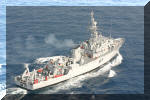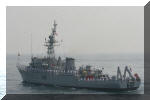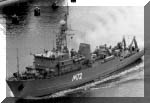- Details
-
Category: Ships
-
Published: Thursday, 02 February 1978 00:00
-
Written by Ocean Minesweeper
-
Hits: 24997









Vessel Type: Ocean Minesweeper. (Natya 1 Class)
Names & Pennant Numbers with commission dates:
INS Pondicherry M61 (02 February 1978), decommissioned
INS Porbandar M62 (19 December 1978), decommissioned
INS Bedi M63 (27 April 1979), decommissioned on 22 Sep 2009
INS Bhavnagar M64 (27 April 1979), decommissioned on 26 Dec 2009
INS Alleppey M65 (10 June 1980)
INS Ratnagiri M66 (10 June 1980)
INS Karwar M67 (14 July 1986)
INS Cannanore M68 (17 December 1987)
INS Cuddalore M69 (29 October 1987)
INS Kakinanda M70 (23 December 1986)
INS Kozhikode M71 (19 December 1988)
INS Konkan M72 (08 October 1988)
Structure: The vessels are fitted with steel hulls but they do not have stern ramps as in the Russian models.
Displacement: 804 tons full load.
Main Machinery: Two diesel engines with 5000 hp sustained, 2 shafts and cp props.
Maximum Speed: 16 knots.
Maximum Range: 3000 miles at 12 knots.
Complement: 82 (incl. 10 officers).
Radar: Air/Surface; One Don 2 radar at I-band frequency.
.........IFF; 2 (NATO: Square Head - High Pole B) radars.
.........Fire Control; Refer to 'Weapons' sub-section.
Sonar: MG-69/79, hull mounted which has active mine detection, with high frequency.
Weapons: All vessels have four 30mm guns with 85º elevation, 500 rounds a minute to 2.7n miles; 5 km and four 25mm guns with 85º elevation, 270 rounds a minute to 1.6n miles; 3 km. Fire control is provided by a single MR-104 (NATO: Drum Tilt) radar at H/I-band frequency. Also fitted with two RBU-1200 5-tubed fixed mortars with a range of 1200 meters. Can also carry 10 mines. Some boats are fitted with a pair of quad 9K32M Strela-2 (SA-N-5) SAM launchers.
Countermeasures: 1 AT-2 acoustic sweep.
.........................1 GKT-2 contact sweep.
.........................1 TEM-3 magnetic sweep.
Comments: INS Pondicherry was painted white and used as the Presidential yacht for the Fleet Review by President R. Venkataraman, on 15 February 1989. She reverted to her normal role and colour on completion. One vessels serves as an AGI (intelligence collection ship). The last six vessels were delivered out of pennant order. These vessels constitute the 19 and 21 MCM Squadrons. M61 - M66 are based at Mumbai and M67 - M72 are based at Vizag. These vessels carry three types of sweeps - TEM-3, AT-2 and MT-1 which are streamed from their quarter-deck. The ship's hull is made of special U3 steel to reduce its own magnetic signature. These sweeps act as mine-counter equipment and can detect various types of mines such as electro-magnetic influenced mines, acoustically influenced mines, moored mines, etc. The TEM-3 and AT-2 sweeps simulate various signatures that a ship might produce, which in turn causes the mine to explode.
The Times of India reported on 09 January 2006, that eight of the vessels are planned to be decommissioned between 2006 and 2008, while the remaining four are undergoing mid-life refits to extend their operational life. India PR Wire reported on 08 January 2008, that Thales of France has signed a $50 million deal, which will involve refitting four to six Pondicherry Class minesweepers into advanced mine hunters. The sonar suites and combat systems will be replaced, which will give the upgraded vessels leading edge capabilities. These vessels are equally divided between the Western and Eastern Naval Commands, but it is unsure which boats will undergo the mid-life upgrade. What is certain however, is that the refits will take place at Visakhapatnam and thus it is likely that the upgraded vessels will be the ones that are currently stationed there. Officials from Thales Underwater Systems will conduct the refits in collaboration with the Indian Navy and the project will reportedly take four years to complete.

















